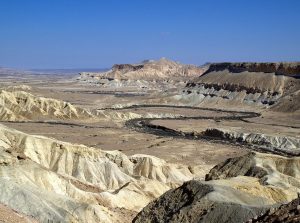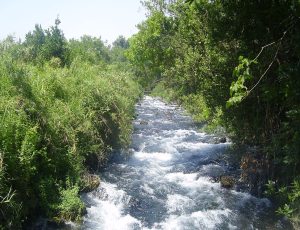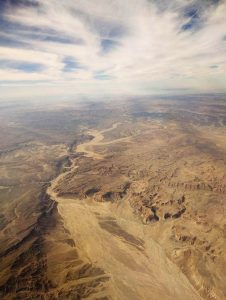In our last section of Sotah we come to the stark and unsettling laws of the eglah arufa, the calf that has to be slaughtered if a murder is committed and no one knows who did it. One of the details of this ritual is that the elders of the city must take the calf down to a nahal eitan נחל איתן:
“and the elders of that town shall bring the heifer down to a nahal eitan, which is not tilled or sown. There, in the wadi, they shall break the heifer’s neck.” (Devarim 21:4)
I am deliberately not translating the words because if you look at different English translations of these two words you will see a marked difference. The JPS and others translate the words as an “everflowing wadi,” the Koren and the Metsudah, as well as the old version of the JPS say it is a “stony valley” or a “rough ravine.” Does this nahal have water or is it just a deep cut in the earth?
The translations continue the argument that is in the classic commentators as well as the Gemara about the meaning of the words nahal eitan. But before we get there, it is interesting to note its meaning in modern Hebrew. If you go on a hike in Israel, chances are good it will involve a nahal נחל. You tell the kids, they are excited -water, hurray! But no, most of the time the nahal is what is known as a nahal achzav נחל אכזב, a riverbed that does not “keep its promise” of having water, i.e., a seasonal river that only flows in the winter. A better English word would be “gorge,” which does not imply water. The Arabic word wadi is similar, a topographical feature that may or may not have water.

Nahal Zin in the Negev
David Shankbone, CC BY 3.0 <https://creativecommons.org/licenses/by/3.0>, via Wikimedia Commons
In contrast to that is the nahal eitan, the “strong” riverbed, that flows with water all year long, because its source is a spring and not rain. A good example of such a riverbed is at Tel Dan where the mighty Dan river flows out of the spring and eventually into the Jordan River:

Nahal Dan
user:netanel_h, CC BY-SA 3.0 <http://creativecommons.org/licenses/by-sa/3.0/>, via Wikimedia Commons
This sense of a flowing riverbed is famously used in the beautiful image of the prophet Amos:
וְיִגַּ֥ל כַּמַּ֖יִם מִשְׁפָּ֑ט וּצְדָקָ֖ה כְּנַ֥חַל אֵיתָֽן׃
But let justice well up like water,
Righteousness like an unfailing stream. (Amos 5:24)
But is this what the Torah has in mind when it calls for the elders to go down to a nahal eitan? Not according to the Mishnah and the Gemara:
“The Sages taught: From where is it derived that eitan is forceful? It is as it is stated: “Firm [eitan] is your dwelling-place, and your nest is set in the rock” (Numbers 24:21) (Sotah 46a-b)
Rashi explains that the parallel in the verse quoted is between eitan and sela, eitan and rock, so clearly eitan means rocky. He follows this line of reasoning in his Torah commentary as well and describes the nahal eitan as קשה, harsh or hard.
Rabbi Saadia Gaon and the Aramaic commentaries do the same. No one mentions water, all talk about a place that is rocky and hard. But a shift is detected in Maimonides, both in his commentary on the Mishnah and in particular in his explanation of the law of the calf in the Mishnah Torah:
“They bring the calf to a river that flows forcefully. This is the meaning of the term eitan found in the Torah (Deuteronomy 21:4)” (Maimonides, Mishneh Torah, Laws of the Murderer and the Preservation of Life (הלכות רוצח) 9:2)
Maimonides’ explanation is that the nahal has to have water, in fact a very strong flow of water. Other commentators, and as we have seen, modern translations, follow him, citing the prooftext we have seen in Amos as well as another one in Tehillim: 74:15
אַתָּ֣ה בָ֭קַעְתָּ מַעְיָ֣ן וָנָ֑חַל אַתָּ֥ה ה֝וֹבַ֗שְׁתָּ נַהֲר֥וֹת אֵיתָֽן׃
it was You who released springs and torrents,
who made mighty rivers run dry;
Some also add that the Torah verse says that the elders need to wash their hands by the nahal, therefore there must be water there:
Which of these choices is correct? Is the nahal a dry but impressive ravine or a powerful stream? Water would seem to imply atonement and a washing away of sins. Shadal (Rabbi Shmuel David Luzzato, 1800-1865, Italy) is disturbed by this interpretation. He strongly supports Rashi’s explanation over Maimonides and explains that the blood of the calf should not be washed away, its purpose is to remain on the stones and show everyone that a murder has been committed. He also explains that the hand washing is not done with water from the nahal, rather the word nahal is connected to the fact that the calf’s neck is broken over the nahal. Water is brought from home to wash the elders’ hands.
Rabbi Yoel Elitzur, in his book in Places in the Parsha, brings the various interpretations and adds an interesting note. For those who say that clearly nahal eitan is one with water, as we see in Amos and Tehillim, he cites his father who explained that there is a difference between poetic language and prose. A nahal eitan in Amos’ poetry must be a powerful stream, washing away injustice. But in the legal, prosaic sections of the Torah, it does not have to mean the same thing. In fact, Amos may be alluding to the Torah’s use of the words in the context of an unsolved murder, and using them deliberately to talk about justice. He borrows the words but adds the extra element of water and washing away sin.
Rabbi Elitzur also adds a very important point, one that is obvious to anyone who reads the verses and knows the topography of the land of Israel. There are very few “everflowing wadis” in Israel. Even our one river, the Jordan, pales in comparison to real rivers like the Nile, Euphrates and the Rhine. If a murder happens in the Negev, which nahal eitan will the elders go to? They are not traipsing up to Tel Dan, many miles away, to do the ceremony. It must be that that they are going out to a rocky ravine, which is a common feature in Israel’s landscape.
So why do Maimonides and later commentators switch from a ravine to a river? Rabbi Elitzur says that they are basing their interpretations on the landscape they were familiar with. Maimonides lived in Egypt, beside the Nile. Others lived in Europe with its majestic rivers. And Rashi and the Rhine? Rashi had a deep feeling for the land of Israel, and much understanding of it, despite never having visited here. That sense of the nature of the land comes through in his interpretation.
The land and the law are tied together inextricably. One is channeled through the other and only in Eretz Yisrael can we truly understand the meaning of the Torah.

Nahal Paran in the Negev
Nizzan Cohen, CC BY-SA 4.0 <https://creativecommons.org/licenses/by-sa/4.0>, via Wikimedia Commons
This article is based on Rabbi Elitzur’s article on Parshat Shoftim in his book Places in the Parsha. Thanks to Rabbi Shalom Berger for bringing it to my attention.










